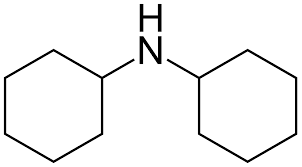HI! I’M ELEMENT AI.
Dicyclohexylamine

Product Description
Dicyclohexylamine, a secondary amine with a bicyclic structure, finds its utility across various industrial sectors.
Product:
Dicyclohexylamine
CAS:
101-83-7
Synonym:
N-Cyclohexylcyclohexanamine;
Structure:

Typical Characteristics
Appearance
Colorless liquid
Boiling point
256 °C
Density
0.9104 g/cm3
Flash Point
105 °C
Melting point
-0.1 °C
Molecular Weight
181.32
Odor
Faint fishy odor
Purity
99%
Refractive index
1.4823
Uses, Applications & Markets
Key applications
get a quote
We Offer Dicyclohexylamine
in various grades
A few of the grades available are listed below:



Dicyclohexylamine used in many
industry applications
Dicyclohexylamine, a secondary amine with a bicyclic structure, finds its utility across various industrial sectors. Below are some of its primary applications:
- Corrosion Inhibitor: Dicyclohexylamine acts as a corrosion inhibitor in boiler water treatment chemicals and in metalworking fluids to protect metal surfaces from corrosion, particularly in systems that are susceptible to acidic conditions.
- Rubber Industry: It is used as a vulcanization accelerator in the manufacturing of rubber products, enhancing the cross-linking process which improves the elasticity, strength, and durability of rubber materials.
- Organic Synthesis: Serving as an intermediate in the synthesis of dyes, pharmaceuticals, and agricultural chemicals, dicyclohexylamine is a versatile building block in organic chemistry.
- CO2 Scrubber: In gas treatment processes, it is utilized as a CO2 scrubbing agent where it absorbs carbon dioxide from gas streams, thereby purifying them for further use or preventing the release of CO2 into the atmosphere.
- Textile Chemicals: It finds application in the textile industry as a neutralizer of acidic waste streams and as a catalyst in the production of synthetic fibers, improving the process efficiency and quality of the final product.
- Pharmaceuticals: As an intermediate in pharmaceutical manufacturing, dicyclohexylamine is involved in the production of various medicinal compounds, contributing to treatments for a range of conditions.
- Agrochemicals: In the agricultural sector, it serves as a precursor in the production of pesticides and herbicides, helping to protect crops from pests and improve agricultural productivity.
- Personal Care Products: Its antimicrobial properties are leveraged in the formulation of personal care products, such as cosmetics and skin care products, to preserve the product and extend its shelf life.